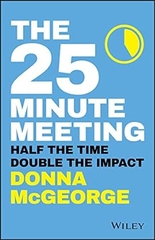-
-
-
Tổng tiền thanh toán:
-
-
Thông tin
-
Tìm sách theo yêu cầu
Book Description
Release date: August 21, 2007 | ISBN-10: 142720232X | ISBN-13: 978-1427202321 | Edition: Unabridged
John Kotter, the world's foremost expert on business leadership, distills twenty-five years of experience into Leading Change. A must-have for any organization, this visionary and very personal audiobook is at once inspiring, clear-headed, and filled with important implications for the future.
The pressures on organizations to change will only increase over the next decades. Yet the methods managers have used to strengthen their companies--total quality management, reengineering, right sizing, restructuring, cultural change, and turnarounds--routinely fall short. In Leading Change, Kotter identifies an eight-step process that every company must go through to achieve its goal, and shows where and how people--good people--often derail. Emphasizing again and again the critical need for leadership to make change happen, Leading Change provides unprecedented access to our generation's business master and a positive role model for leaders to emulate.
The pressures on organizations to change will only increase over the next decades. Yet the methods managers have used to strengthen their companies--total quality management, reengineering, right sizing, restructuring, cultural change, and turnarounds--routinely fall short. In Leading Change, Kotter identifies an eight-step process that every company must go through to achieve its goal, and shows where and how people--good people--often derail. Emphasizing again and again the critical need for leadership to make change happen, Leading Change provides unprecedented access to our generation's business master and a positive role model for leaders to emulate.
Editorial Reviews
From Publishers Weekly
Harvard Business School professor Kotter (A Force for Change) breaks from the mold of M.B.A. jargon-filled texts to produce a truly accessible, clear and visionary guide to the business world's buzzword for the late '90s?change. In this excellent business manual, Kotter emphasizes a comprehensive eight-step framework that can be followed by executives at all levels. Kotter advises those who would implement change to foster a sense of urgency within the organization. "A higher rate of urgency does not imply everpresent panic, anxiety, or fear. It means a state in which complacency is virtually absent." Twenty-first century business change must overcome overmanaged and underled cultures. "Because management deals mostly with the status quo and leadership deals mostly with change, in the next century we are going to have to try to become much more skilled at creating leaders." Kotter also identifies pitfalls to be avoided, like "big egos and snakes" or personalities that can undermine a successful change effort. Kotter convincingly argues for the promotion and recognition of teams rather than individuals. He aptly concludes with an emphasis on lifelong learning. "In an ever changing world, you never learn it all, even if you keep growing into your '90s." Leading Change is a useful tool for everyone from business students preparing to enter the work force to middle and senior executives faced with the widespread transformation in the corporate world. 60,000 first printing; $100,000 ad/promo; dual main selection of the Newbridge Book Club Executive Program; 20-city radio satellite tour.
Copyright 1996 Reed Business Information, Inc. --This text refers to an out of print or unavailable edition of this title.
Copyright 1996 Reed Business Information, Inc. --This text refers to an out of print or unavailable edition of this title.
From Library Journal
After trying an endless array of quick fixes and other panaceas, executives struggling to stay in business in a rapidly changing world are finding it necessary to consider more fundamental reasons for their lack of success. Kotter (The New Rules: A Force for Change, Free Pr., 1995) now offers a practical approach to an organized means of leading, not managing, change. He presents an eight-stage process of change with highly useful examples that show how to go about implementing it. Based on experience with numerous companies, his sound advice gets directly at reasons that organizations fail to change, reasons that concern primarily the leader. This is a solid, substantive work that goes beyond the cliches and the consultant-of-the-month's express down yet another dead-end street. With its clear demonstration of the hard work necessary to lead change, this important work stands with Michael Hammer's latest, Beyond Reengineering (see review above). Highly recommended.?Dale F. Farris, Groves, Tex.
Copyright 1996 Reed Business Information, Inc. --This text refers to an out of print or unavailable edition of this title.
Copyright 1996 Reed Business Information, Inc. --This text refers to an out of print or unavailable edition of this title.
Most Helpful Customer Reviews
211 of 232 people found the following review helpful
5.0 out of 5 stars "The Eight Steps to Transformation" October 22, 2000
Format:Hardcover
"Over the past decade," John P. Kotter writes, "I have watched more than a hundred companies try to remake themselves into significantly better competitors. They have included large organizations (Ford) and small ones (Landmark Communications), companies based in United States (General Motors) and elsewhere (British Airways), corporations that were on their knees (Eastern Airlines), and companies that were earning good money (Bristol-Myers Squibb). Their efforts have gone under many banners: total quality management, reengineering, right-sizing, restructuring, cultural change, and turnaround. But in almost every case the basic goal has been the same: to make fundamental changes in how business is conducted in order to help cope with a new, more challenging market environment. A few of these corporate change efforts have been very successful. A few have been utter failures. Most fall somewhere in between, with a distinct tilt toward the lower end of the scale. The lessons that can be drawn are interesting and will probably be relevant to even more organizations in the increasingly competitive business environment of the coming decade."
In this context, John P. Kotter lists the most general lessons to be learned from both (I) the more successful cases and (II) the critical mistakes as follows:
I. Lessons from the more successful cases:
1. Establishing a sense of urgency
* Examining market and competitive realities
* Identifying and discursing crises, potential crises, or major opportunities
2. Forming a powerful guiding coalition
* Assembling a group with enough power to lead the change effort
* Encouraging the group to work together as a team
3. Read more ›
In this context, John P. Kotter lists the most general lessons to be learned from both (I) the more successful cases and (II) the critical mistakes as follows:
I. Lessons from the more successful cases:
1. Establishing a sense of urgency
* Examining market and competitive realities
* Identifying and discursing crises, potential crises, or major opportunities
2. Forming a powerful guiding coalition
* Assembling a group with enough power to lead the change effort
* Encouraging the group to work together as a team
3. Read more ›
36 of 36 people found the following review helpful
5.0 out of 5 stars Will you lead change? November 20, 2012
By Dane Harison
Format:Hardcover
I highly recommend this book for its easy-to-read-and-grasp approach to managing change. The book outlines an eight-stage change process that is intuitive and methodical. Kotter shows a change agent what to look for, what to emphasize, and how to orchestrate and maneuver through any organizational change. I appreciate the book's instructional tone without all the business jargon. As a leadership book, I consider it one of my two must reads (the other is Leadership 2.0).
Here's what's inside "Leading Change":
Part I: The Change Problem and Its Solution
1. Transforming Organizations: Why Firms Fail
2. Successful Change and the Force That Drives It
Part II: The Eight-Stage Process
3. Establishing a Sense of Urgency
4. Creating the Guiding Coalition
5. Developing a Vision and Strategy
6. Communication the Change Vision
7. Empowering Employees for Broad-Based Action
8. Generating Short-Term Wins
9. Consolidating Gains and Producing More Change
10. Anchoring New Approaches in the Culture
Part III: Implications For the Twenty-First Century
11. The Organization of the Future
12. Leadership and Lifelong Learning
Here's what's inside "Leading Change":
Part I: The Change Problem and Its Solution
1. Transforming Organizations: Why Firms Fail
2. Successful Change and the Force That Drives It
Part II: The Eight-Stage Process
3. Establishing a Sense of Urgency
4. Creating the Guiding Coalition
5. Developing a Vision and Strategy
6. Communication the Change Vision
7. Empowering Employees for Broad-Based Action
8. Generating Short-Term Wins
9. Consolidating Gains and Producing More Change
10. Anchoring New Approaches in the Culture
Part III: Implications For the Twenty-First Century
11. The Organization of the Future
12. Leadership and Lifelong Learning
134 of 150 people found the following review helpful
5.0 out of 5 stars Make Change Irresistibly Attractive April 19, 2000
Format:Hardcover
The leaders of some organizations have no idea how to make successful changes, and are likely to waste a lot of resources on unsuccessful efforts. Professor Kotter has done a solid job of outlining the elements that must be addressed, so now your organization will at last know what they should be working on.
On the other hand, if you have not seen this done successfully before, you may need more detailed examples than this book provides or outside facilitators to help you until you have enough experience to go solo. I suspect this book will not be detailed enough by itself to get you where you want to go.
Here's a hint: The Harvard Business Review article by Professor Kotter covers the same material in a much shorter form. You can save time and money by checking this out first before buying the book.
I personally find that measurements are very helpful to create self-stimulation to change, and this book does not pay enough attention in that direction. If you agree that measurements are a useful way to stimulate change, be sure to read The Balanced Scorecard, as well, which will help you understand how to use appropriate measurements to make more successful changes.
If you want to know what changes to make, this book will also not do it for you. I suggest you read Peter Drucker's Management Challenges for the 21st Century and Peter Senge's Fifth Discipline.
Good luck!
On the other hand, if you have not seen this done successfully before, you may need more detailed examples than this book provides or outside facilitators to help you until you have enough experience to go solo. I suspect this book will not be detailed enough by itself to get you where you want to go.
Here's a hint: The Harvard Business Review article by Professor Kotter covers the same material in a much shorter form. You can save time and money by checking this out first before buying the book.
I personally find that measurements are very helpful to create self-stimulation to change, and this book does not pay enough attention in that direction. If you agree that measurements are a useful way to stimulate change, be sure to read The Balanced Scorecard, as well, which will help you understand how to use appropriate measurements to make more successful changes.
If you want to know what changes to make, this book will also not do it for you. I suggest you read Peter Drucker's Management Challenges for the 21st Century and Peter Senge's Fifth Discipline.
Good luck!
XEM THÊM TẠI AMAZON.COM
- Thông tin chi tiết
- Mục lục
- Đọc thử
- Đọc thử
- Đánh giá & bình luận của người mua
- Những cuốn sách cùng chủ đề hoặc có liên quan
Link: http://www.amazon.com/Leading-Change-John-Kotter/dp/142720232X/
Tại web chỉ có một phần nhỏ các đầu sách đang có nên nếu cần tìm sách gì các bạn có thể liên hệ trực tiếp với Thư viện qua Mail, Zalo, Fanpage nhé
Đăng ký nhận tin qua email
Hãy đăng ký ngay hôm nay để nhận được những tin tức cập nhật mới nhất về sản phẩm và các chương trình giảm giá, khuyến mại của chúng tôi.












